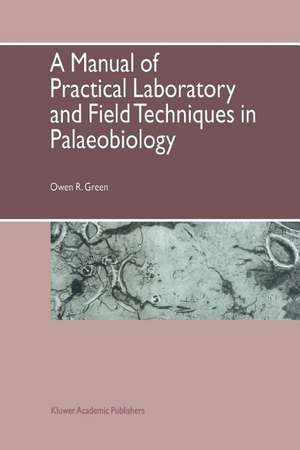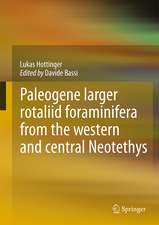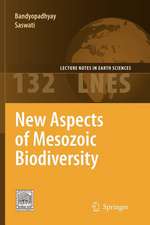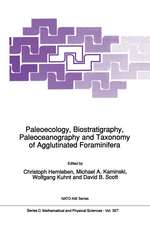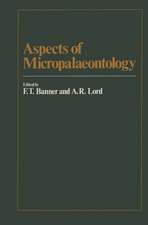A Manual of Practical Laboratory and Field Techniques in Palaeobiology
Autor O.R. Greenen Limba Engleză Paperback – dec 2010
| Toate formatele și edițiile | Preț | Express |
|---|---|---|
| Paperback (1) | 1223.57 lei 6-8 săpt. | |
| SPRINGER NETHERLANDS – dec 2010 | 1223.57 lei 6-8 săpt. | |
| Hardback (1) | 1237.80 lei 6-8 săpt. | |
| SPRINGER NETHERLANDS – 30 apr 2001 | 1237.80 lei 6-8 săpt. |
Preț: 1223.57 lei
Preț vechi: 1492.16 lei
-18% Nou
Puncte Express: 1835
Preț estimativ în valută:
234.13€ • 255.12$ • 197.29£
234.13€ • 255.12$ • 197.29£
Carte tipărită la comandă
Livrare economică 23 aprilie-07 mai
Preluare comenzi: 021 569.72.76
Specificații
ISBN-13: 9789048140138
ISBN-10: 9048140137
Pagini: 556
Ilustrații: XIV, 538 p.
Dimensiuni: 155 x 235 x 29 mm
Greutate: 0.77 kg
Ediția:Softcover reprint of hardcover 1st ed. 2001
Editura: SPRINGER NETHERLANDS
Colecția Springer
Locul publicării:Dordrecht, Netherlands
ISBN-10: 9048140137
Pagini: 556
Ilustrații: XIV, 538 p.
Dimensiuni: 155 x 235 x 29 mm
Greutate: 0.77 kg
Ediția:Softcover reprint of hardcover 1st ed. 2001
Editura: SPRINGER NETHERLANDS
Colecția Springer
Locul publicării:Dordrecht, Netherlands
Public țintă
ResearchCuprins
1 Palaeontological Techniques — an introduction to practical procedures.- 2 Documentation in the Laboratory.- 3 Field collecting procedures.- 4 Collecting techniques for microfossil and live foraminifera.- 5 Consolidation, stabilization and replication techniques.- 6 Field staining techniques for determining calcite, dolomite and phosphate.- 7 Field documentation, sample packing and transportation.- 8 Laboratory design and layout.- 9 Safety in the laboratory.- 10 Preservation, consolidation and repair of unstable specimens.- 11 Preparation of recent material for comparative studies.- 12 Mechanical methods for preparing fossil specimens.- 13 Fossil extraction techniques by thermal disintegration.- 14 Disaggregation and dispersal of partially consolidated and unconsolidated sediments.- 15 Microfossil sample contamination and reliability problems.- 16 Washing and sieving techniques used in micropalaeontology.- 17 Centrifuge techniques used in micropalaeontology.- 18 Mechanical separation of microfossil residues.- 19 Flotation and liquid separation techniques.- 20 Thin section and slide preparation techniques of macro and microfossil specimens.- 21 Staining techniques used in micropalaeontology.- 22 Preparation of carbonate stained acetate peels and thin sections.- 23 Preparation of amber specimens containing fossils.- 24 Preparation and conservation of vertebrate fossils.- 25 Extraction techniques for palaeobotanical and palynological material.- 26 Extraction techniques for acid insoluble microfossils.- 27 Extraction techniques for phosphatic fossils.- 28 Extraction techniques for uncrushed graptolites.- 29 Extraction techniques for calcareous microfossils from argillaceous sediments.- 30 Extraction techniques for calcareous microfossils from carbonate sediments.- 31Extraction techniques for agglutinated foraminifera from calcareous sediments.- 32 Specialist techniques used in the preparation of individual microfossil specimens.- 33 Extraction techniques for calcareous nannofossils.- 34 Electron microscopy techniques.- 35 X-radiography techniques.- 36 Fossil replication techniques.- 37 Photomacrography and photomicrography techniques.- 38 Illustrating and exhibiting for display and publication.- References.- 1 Equipment and chemical suppliers.- 2 Describing sedimentary rocks and fossils.- 3 Centrifuge times for bromoform separation and water/acetone residue washing.- 4 Hazard symbols.- 5 Respirator and filter cartridge colour coding.- 6 Fire extinguisher classification.- 7 Laboratory glove resistance properties.- 8 Care and handling of hydrofluoric acid.- 9 Spillage and disposal of unwanted chemicals.- 10 Conversion data.- (i) Temperature.- (ii) Weight.- (iii) Volume.- (iv) Length.- 11 Formulae for the preparation of standard solutions.- (i) Weight % (w/w).- (ii) Volume % (v/v).- (iii) WeightNolume % (w/v).- (iv) Mole Fraction.- (v) Standard solutions.- Indexs.- Author Index.- Chemical Index.
Recenzii
`This book is very well organized and information is easy to find. [...]many of the techniques will be of use to Holocene workers[...] but all geological departments that undertake research should have a copy for reference. This book will be an invaluable guide to geologists from undergraduate level upwards.[..]But always one must return to the sheer magnitude of the data contained within the 538 pages of this excellent book. It is not just a field techniques and paleobiology laboratory manual, but instead represents a most impressive gathering together of almost everything a successful practical paleobiologist needs to be effective. [...]This manual has managed to fill a gap in the market, which has existed for several years. In the last few decades developments in paleobiological field and laboratory techniques have generally been published as booklets or papers. Green has successfully brought these together here, to produce what will be valued by many as a standard reference on the subject. '
Caroline Buttler, National Museums and Galleries of Wales in Holocene
Caroline Buttler, National Museums and Galleries of Wales in Holocene
